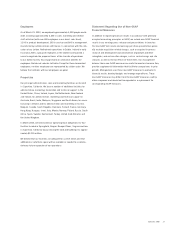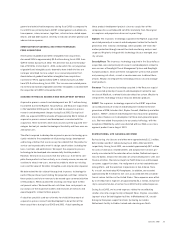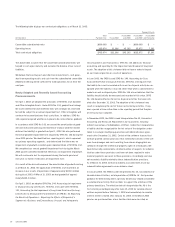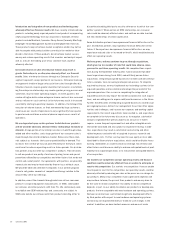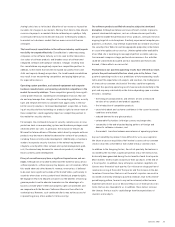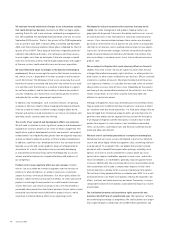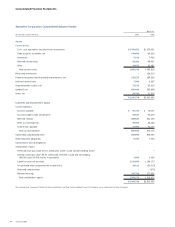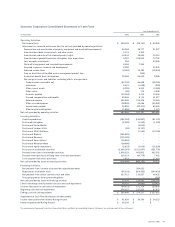Symantec 2003 Annual Report Download - page 39
Download and view the complete annual report
Please find page 39 of the 2003 Symantec annual report below. You can navigate through the pages in the report by either clicking on the pages listed below, or by using the keyword search tool below to find specific information within the annual report.
Symantec 2003 37
operating leases under synthetic lease transactions by purchasing the
land and buildings for approximately $17.9 million and $106.0 million,
respectively. As such, we had no interest in any variable interest entities
as of March 31, 2003.
In May 2003, the FASB issued SFAS No. 150, Accounting for Certain
Financial Instruments with Characteristics of both Liabilities and Equity,
which provides guidance for classification and measurement of certain
financial instruments with characteristics of both liabilities and equity.
SFAS No. 150 is effective for financial instruments entered into or modi-
fied after May 31, 2003, and otherwise is effective at the beginning of
the first interim period beginning after June 15, 2003. The adoption of
this statement will not have an impact on our financial position or
results of operations.
Business Risk Factors
There is uncertainty as to whether or not we will be able to sustain
the growth rates in sales of our products, particularly in consumer
antivirus protection products. During fiscal 2003 and the second half
of fiscal 2002, we experienced a higher than expected rate of growth
in sales of our consumer antivirus protection products, and we expect
that we will not be able to sustain this high growth rate on a consistent
basis. We believe that consumer antivirus sales have been spurred by a
number of factors over the past six quarters, including increased broad-
band connection, increased awareness of security threats to consumer
systems, particularly the well-publicized Code Red, Nimda, Klez,
Opaserv, Yaha, Bugbear, Lovegate and Slammer threats and a reaction
from the September 11, 2001 terrorist attacks. The impact of these
factors is likely to diminish over time, and it is possible that growth
rates in sales of antivirus protection products may decline.
Our efforts to develop and sell appliances and integrated solutions
involve risk. We have recently begun selling appliances in which our
software is embedded with hardware. Because of our limited experience
with the manufacture of appliances, and because our appliances gener-
ate lower gross margins than our software products, our efforts to
develop and sell appliances may not be as successful as we anticipate.
In addition, our strategy for future growth includes integrating our vari-
ous security technologies, management, customer service and support
into a single enterprise security solution. We have begun implementing
this strategy by selling integrated solutions, such as Symantec Gateway
Security and Symantec Client Security. Our integrated solutions may
not achieve market acceptance and may not be able to compete with
solutions either currently in the market or introduced in the future. If
we are unable to achieve market acceptance or compete effectively with
solutions of our competitors, our future net revenues and operating
results could be adversely affected.
Economic and political conditions and conditions affecting the
network security market in particular may have a negative impact on
our revenues and margins. The market for our products depends on
economic conditions affecting the broader network security, Internet
infrastructure and related markets. More generally, the slowdown in the
U.S. economy may hurt consumer demand for our products. On the
enterprise side, the continued slowdown in corporate earnings and
tightening of corporate budgets may cause potential customers to delay
or cancel security projects, reduce their overall or security-specific
information technology budgets, or reduce or cancel orders for our
products. Further, in this environment, customers may experience finan-
cial difficulty, cease operations or fail to budget for the purchase of our
products. This, in turn, may lead to longer sales cycles, price pressures
and collection issues, causing us to realize lower revenues and margins.
In addition, the terrorist acts of September 11, 2001 and the fall-out
of the war in the Middle East have created an uncertain economic and
political environment in many parts of the world, and we cannot predict
the impact of these events, or of any related military action, on our
customers or business.
We face risks associated with our foreign operations. A significant
portion of our manufacturing costs and operating expenses result from
transactions outside of the United States, often in foreign currencies.
Our international sales have been increasing as a percentage of our total
sales and, for the first time during the third and fourth quarter of fiscal
2003, comprised slightly more than 50% of our total sales. In fiscal year
2003, our operating results have been positively affected by changes in
foreign currency rates. Our future operating results will continue to be
subject to fluctuations in foreign currency rates, especially if interna-
tional sales continue to grow as a percentage of our total sales, and we
may be negatively impacted by fluctuations in foreign currency rates in
the future. Our operating results could also be adversely affected by
general uncertainty with each country’s political and economic struc-
ture. In addition, governmental regulation of imports or exports or our
failure to obtain any required export approval of our technologies, par-
ticularly our encryption technologies, could impede our international
sales. In light of recent terrorist activity and political and military insta-
bility internationally, governments could enact additional regulation or
restrictions on the use, import or export of encryption technologies.
Additional regulation of encryption technologies could delay or prevent
the acceptance and use of encryption products and public networks for
secure communications. This might decrease demand for our products
and services.
In addition, the outbreak of Severe Acute Respiratory Syndrome (SARS)
could have an adverse impact on our operations in Asia. If there is a sig-
nificant spread of SARS beyond Asia, other aspects of our operations
could be negatively impacted.
Demand for our products is subject to seasonal trends. Although there
is no assurance this trend will continue, our sales of consumer products
over the last seven years have been seasonal, with higher sales gener-
ally in our December and March quarters. In addition, we anticipate that
sales of enterprise security products may be higher in the March quarter
in the future, as our sales force attempts to close transactions before
the end of our fiscal year. To the extent seasonality makes it more diffi-
cult to predict our revenues and value our business, our stock price may
suffer and the volatility of our stock may increase.


